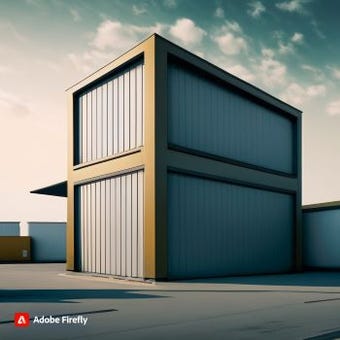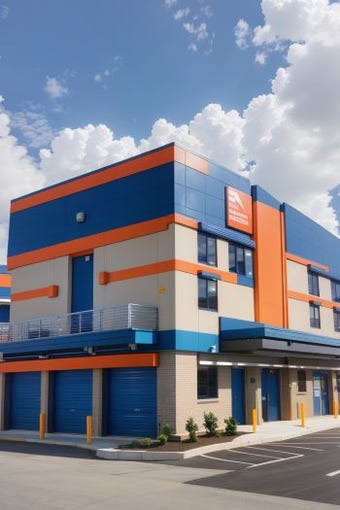Splat! A Generative-AI Exploration Into Self-Storage Design That Falls Flat
Artificial intelligence (AI) clearly has some self-storage business applications. So, after ChatGPT impressed with its written knowledge of the industry, how would generative AI platforms do with presenting visual interpretations of facility design and business logos? Well, scroll down to see for yourself!

Earlier this year, I conducted a Q&A session with ChatGPT to try to get a baseline reading on what it understood about the operational and investing sides of the self-storage industry. I came away impressed by the responses to my prompts and encouraged that artificial intelligence (AI) could make a useful tool when integrated with operational systems to assist with everything from complex data analysis to answering live inquiries from prospective customers.
The buzz about AI hasn’t slowed down. If anything, it’s picked up as millions of people and businesses have toyed with the dozens of platforms that are now available. In particular, generative AI has received a lot of media coverage because of the sophistication of some of the results. Everything from fake music recordings to realistic images of famous people in situations that never actually occurred have been published and disseminated online.
In many cases, users have created some stunning images using text prompts. The beauty of generative models is the ability to produce visuals using only a few words and then tweak and change creations to improve them. Thus, I’ve been curious about the use of generative AI in self-storage, particularly as it relates to design creation.
On the surface, I can envision how these tools can be leveraged to enhance facility design and quickly come up with fresh concepts for business logos, advertisements, marketing campaigns and more. I have no doubt that in the right hands, they could be immensely useful. I also think that with the right prompts, a self-storage owner or manager could generate some design ideas that could be further fleshed out by a professional.
Exterior Design
Thus, similar to my interview with ChatGPT, I was really curious to see what the baseline level visual understanding or interpretation of self-storage was by some of these generative AI platforms. To see what the most basic returns would be, I gave four different platforms (Adobe Firefly, Bing Image Creator, Leonardo AI and Picsart) the exact same prompt: “Typical exterior self-storage facility design.”
I’m sorry to say that I came away far less impressed than with the language model discussion. Each platform provided four examples to the query. In all, they ranged from the predictable to the comical. There were even a few that were a bit confounding.
This was particularly true with Adobe Firefly, which offered a couple of pretty traditional looking images, along with a couple of strange offerings that I would hardly call “typical.” Take a look at the image at right below. What the heck is going on here? Is it some kind of two-story, portable storage/unit hybrid? I have no idea if that second story is supposed to open or not, but I have some concerns about liability!


Between the four, Picsart returned the most predictable, basic and dare I say “boring” images. Though, even on these, there are some odd inconsistencies to what we see in the real world. If you look closely, the image at left below seems to go on for infinity, and the image at right could just as easily be some kind of warehouse or distribution/logistics plant.


The two platforms that brought back the most interesting images were Bing Image Creator and Leonardo AI, the latter of which used its DreamShaper module by default. At first, I was immediately impressed by Bing’s suggestions because at first glance, they resembled something much more modern and intricate than Firefly or Picsart. However, if you look closely at the two images below, there’s not much that’s true to self-storage in either.


Still, they’re both interesting. Perhaps with some sophisticated tweaking via the site’s editing functions and further prompts, they could be turned into something useful.
I was most impressed with Leonardo AI. The site gave me something very traditional (below left) as well as an interpretation of something quite modern (below right). The detail on the traditional image, including signage (the only site of the four to include a sign), shadow play and perspective, is quite good. Similar to Bing, the more modern-looking facility initially struck me as intriguing, but closer examination makes me scratch my head as to why the AI included some details, like the balcony on the second floor. Again, that’s hardly “typical.”


Similar to Bing, there’s a lot wrong with the modern-facility image, but it’s at least visually interesting and could perhaps be manipulated further within the Leonardo AI platform. Of all four websites, Leonardo’s seems to have the most robust tools available, even in the free version. You just have to be mindful of the amount of tokens certain actions “cost.” It’s my understanding that the site replenishes free tokens in your account each day.
Logo Design
I was also curious to see what these AI tools would suggest for a business logo. Rather than feed the AI some visual descriptor like “lock” or “security,” or distinctive theme like “Pirate Self-Storage,” I decided to keep it very basic and generic. Again, I gave all four sites the same prompt: “Business logo for XYZ Self-Storage.”
As you can see below, the results were very uneven and mostly underwhelming. It’s possible that there are some limitations or restrictions with regard to copyright concerns within the free tools I was using that prevented them from supplying correct spellings or more useful designs. I’ve included below the “best” from all four platforms.

With this prompt, the returns from Picsart and Bing were very basic and not at all self-storage specific. In fact, two of the Picsart offerings bizarrely returned with “Sensitive content hidden in line with our Community Guidelines” rather than any logo. Why that would be the case, I’m not sure.
Firefly at least generated an interesting mix ranging from simple-but-clean to a couple of looks that were pretty wild. You can even see some attempt at bringing in some storage elements. The best presentation, though, was again from Leonardo AI. It’s the only platform that spelled self-storage correctly (in one spot mind you), and it surprisingly attempted to show logos being put to use on walls and the sides of trucks.
I’m not a graphic designer by any stretch, so my approach may have had its limitations. Still, I found the exercise useful. It would definitely take some time and trial and error to work with these suggestions and move them toward any kind of a finished product. More detailed prompts may have helped, but the goal was to get a baseline, visual indication of what AI considers self-storage. From that standpoint, it was a worthy experiment.
About the Author(s)
You May Also Like







